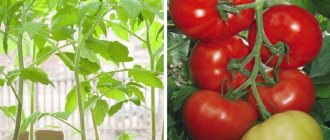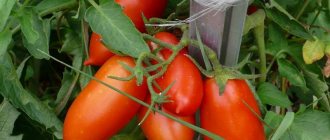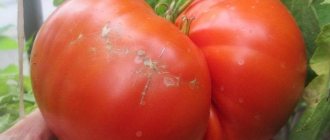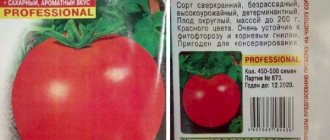The Khokhloma tomato is an excellent variety created by employees of the Research Institute for Breeding Vegetable Crops. The name of the research institute will not be familiar to many vegetable growers, but the brand “Gavrish”, under which the products are produced and sold, is heard by every second gardener.
When creating the variety, breeders tried to take into account all the features of growing tomatoes in any region of the Russian Federation, and their efforts were crowned with success. Testing trial plantings of the Khokhloma tomato, the originators decided on the need to register the variety in the State Register of Approved Seeds, which was done already at the beginning of 2004. And for more than 10 years, Khokhloma tomatoes have been delighting not only lovers of garden farming with their fruiting, but also professional farmers.
Description and characteristics of the variety
- Variety, not hybrid.
- Indeterminate, with unlimited growth, grows up to 2 meters in height.
- The bush is not standard.
- The leaves are medium dark green, wrinkled with slight pubescence.
- The inflorescence is simple, the first is formed after 8-9 leaves, the subsequent ones every 3 leaves. Up to 12 fruits are tied on 1 brush, which are firmly held on the stalk.
- To get a good harvest, it is recommended to grow bushes with 1-2 stems, and then pruning every 10 days. The stepsons are carefully pinched, leaving a stump of 5-7 mm, so as not to injure the main stem.
- Average ripening period. Ripe fruits can be removed from the bush 115-120 days after emergence.
- Resistant to nightshade diseases such as mosaic, late blight, cladosporiosis, fusarium.
- Recommended for growing in a greenhouse. It can be grown in open ground, but only in the southern regions and the yield will be less.
- Productivity is high. From 1 sq.m. (3-4 bushes) harvest up to 10 kg of tomatoes. With proper agricultural technology, 1 bush of the Khokhloma variety produces 5 kg of tomatoes or more.
Sowing seeds for seedlings
Tomatoes of this variety are suitable for growing in greenhouses and open ground, but the yield in the latter case will be slightly lower. Before planting tomatoes in the garden, you should prepare the seedlings.
Optimal timing
If seedlings are planted in a greenhouse, then the optimal period is considered to be the end of March and April. It is recommended to postpone planting in open soil until May, but at the same time check that the soil has warmed up. Its temperature indicators must be at least 14 °C.
Soil mixture
The soil mixture for growing seedlings should be as light as possible, loose, and enriched with nutrients. In most cases, soil with the following composition is used: chernozem and humus in a ratio of 1:2. You can also use a mixture of equal parts of black soil, special soil for seedlings and fine sand. There is no single recipe for soil composition for tomatoes; each one is selected individually.
Find out more about pests and diseases of tomatoes in greenhouses.
If garden soil is used for seedlings, it must be disinfected from possible parasites and pests.
For disinfection, you can use one of the popular methods:
- Calcination of the soil in the oven for 15–20 minutes at a temperature of 180–200 °C.
- Heating the earth in a microwave oven for 1–2 minutes at a power of 850–900 W.
- Disinfection of soil with a solution of potassium permanganate. The soil is filled with a concentrated solution of potassium permanganate and allowed to dry.
Growing container
To sow seeds for seedlings, it is allowed to use any containers: disposable plastic cups, special boxes - cassettes, ordinary rectangular boxes or peat tablets. The latter are the simplest and best option, since they involve further planting of seedlings along with a conditional container.
Seed preparation
Before sowing, tomato seeds must be prepared in a special way.
Important! Store-packaged seedling seeds have already undergone the necessary disinfection and do not require additional processing.
If the seeds were purchased by weight or collected with your own hands, then they should be disinfected using one of the following solutions:
- Dissolve 1 g of potassium permanganate in 100 ml of clean water, place the seeds in a napkin and leave in the mixture for no more than 15–20 minutes;
- Mix 0.5 g of soda with 100 ml of water, soak the seeds in this mixture for about a day;
- Dilute 1 drop of “Fitosporin” in 100 ml of water, immerse the seed material in the solution for 1–2 hours.
Disinfection of seeds will make it possible to neutralize them from possible pests and parasites, and will also strengthen the immunity of seedlings, increase the yield of the plant and its fertility.
Sowing seeds
It is necessary to fill containers for seedlings with previously prepared and disinfected soil and make depressions up to 1 cm in the soil. In this case, the distance between the beards should be 3–4 cm, and the interval between seeds should be 1–2 cm. The seeds should be lowered into the hole and lightly pressed down and carefully sprinkle with soil. After sowing, the soil should be sprayed with water using a spray bottle.
When the soil settles, the container with the seeds must be covered with plastic wrap and placed in a warm, dry place where the temperature varies between 25–30 °C. It is allowed to place boxes near the radiator or heating devices.
Seedling care
It is recommended to check the condition of the seedlings daily. To do this, inspect the soil: if it dries too much, spray it with water from a spray bottle, and if it is too wet, remove the film and dry it.
Important! In some cases, excess moisture in the soil can form mold on its surface. In such cases, the top layer of soil should be removed, replaced with a new one, and the entire soil should be shed with a solution of potassium permanganate.
It is not recommended to reduce the temperature in the room before the first shoots appear, and as soon as they appear, the film must be removed. It is necessary to water the sprouts as the soil dries. For irrigation, it is better to use clean, settled water at room temperature. Rainwater is considered the ideal option.
Growing strong, high-quality seedlings is impossible without good lighting. It is necessary to place containers with seedlings in the brightest place. In the absence of proper lighting, an additional light source should be installed, which can be a traditional fluorescent lamp. 1 week after germination, the temperature in the room should be reduced to 17–19 °C. It is also recommended to ventilate the room daily, but avoid drafts.
2-3 weeks after the sprouts appear, the soil must be enriched with fertilizers, which are then recommended to be applied weekly. For feeding, it is best to use organic products made from manure or grass. Store-bought fertilizers based on biological humus and guano are suitable.
Hardening of seedlings
Approximately 1–1.5 months after planting the seeds, the seedlings expel flower clusters. This is a signal that after 10–15 days it needs to be planted. But before you proceed to planting, you should harden the sprouts, which will increase the plant’s immunity and help it more easily adapt to environmental conditions and recover.
We recommend finding out why tomatoes in a greenhouse don’t turn red.
Hardening is carried out as follows:
- 1–2 weeks before planting seedlings in a permanent place, you need to reduce the temperature in the room at night to 12–14 °C.
- The temperature must be reduced systematically so that 5 days before planting it becomes equal to the ambient temperature. To do this, it is recommended to take the container with the sprouts out onto a glassed-in balcony and leave it there 24 hours a day. Sudden temperature changes should not be allowed.
- In parallel with temperature hardening of the plant, its root system should be hardened by creating more severe conditions - reducing the number of waterings. Irrigation volumes should be left the same, and only the time intervals between soil moistenings should be changed. Such measures will allow you to slightly stop the growth of seedlings and at the same time form a more durable, strong root system. At the same time, it is very important to prevent the soil from drying out, as the seedlings will begin to shed their leaves.
- A few days before planting, it is necessary to fertilize the tomatoes using a solution of ammonium nitrate, potassium sulfate, “Crystallon”. Fertilizers will make it possible to increase the number of established shoots by almost 100%.
- On the last day, the seedlings should be taken out into fresh air and left until directly planted in the ground.
Did you know? In different countries of the world, tomatoes are called apples. For example, in Germany they are called “paradise apples”, and in France they are called “love apples”.
Fruit characteristics
- The pods tie and sing at the same time.
- Unripe tomatoes are light green. The color of ripe tomatoes is bright red.
- The skin is smooth and dense.
- The flesh is dense and crispy.
- The shape is long, cylindrical. The fruits grow up to 1 2 cm in length.
- The average weight of 1 tomato is about 150 g.
- Inside there are 2-3 seed chambers, which contain an average number of seeds.
- Concentration of dry substances up to 4%.
- Has good keeping quality. According to reviews from gardeners, some managed to preserve fresh fruits until the New Year.
- It tolerates transportation well over long distances.
Harvest and storage
Because The yield of the variety is very high, fruiting can last about 1.5-2 months. You can pick tomatoes until the air temperature drops below 9 °C, otherwise the picked fruits will spoil in 1-2 days due to hypothermia. It is not recommended to pick tomatoes in rainy weather: excess moisture has a detrimental effect on their appearance.
Medium-sized fruits with intact skin and dense structure will be stored longer. In boxes or containers, you need to put a ball of paper at the bottom, then place the tomato with the stalk facing up. Vegetables are placed in a cool, dark place with a humidity of no more than 75-80%.
Ventilation is also important. The boxes can be stacked one on top of the other. In such conditions, the fruits do not lose their properties for up to 2 weeks.
Storage conditions differ slightly depending on the color of the fruit.
- The red variety of Khokhloma variety “lies” at a temperature of 1-2 °C;
- Buraya can be stored at 4-6 °C. If you collect green fruits, it is best to store them at a temperature of 10 °C. They are laid out on a bed of straw or hay and ripen slowly, so they remain fresh and tasty until winter.
Advantages and disadvantages
- High yield.
- Long-term fruiting.
- Great taste.
- Resistance to diseases that often affect nightshade crops.
- Good keeping quality.
- Resistance to transportation.
The Khokhloma variety has no obvious disadvantages. However, controversial disadvantages include the high density of the fruit, thick skin and low juice content in tomatoes. Therefore, this variety is not suitable for making juice, but these tomatoes are ideal for whole canning.
Advantages and disadvantages
Based on the characteristics and description of the Khokhloma tomato variety, its strengths are known:
- high yield from a small area;
- persistent immunity to pastelaceae diseases;
- long fruiting;
- fruits of universal use;
- excellent keeping quality and transportability;
- good taste with meaty pulp;
- not subject to cracking.
Some gardeners consider the dense skin of a tomato not an advantage, but a disadvantage of the Khokhloma variety. For fresh consumption, the skin can be removed from the fruit. But in marinades and pickling, tomatoes retain their shape and firmness.
Features of cultivation
The Khokhloma tomato variety is recommended for cultivation throughout Russia (from the Southern regions to Siberia ), as well as in Ukraine.
Tomatoes are sown as seedlings in March, first disinfected in a weak solution of potassium permanganate, washed and listened to. The seeds are buried 2 cm in light soil and left in a warm place for germination. Not watered often. With the appearance of 1-2 true leaves, they are picked into separate large-volume cups.
Advice! It is better to use settled, warm water for irrigation.
10-14 days before transplanting the seedlings to the main place, they are hardened off. Transplantation into a greenhouse is carried out in April, when the seedlings have grown to 20-25 cm. Seedlings are planted in open ground at the end of May.
It is recommended to grow tomatoes, according to the rules of crop rotation, in the place where they grew before:
- Cabbage;
- Carrot;
- Onion.
Immediately after planting, it is recommended to tie the bushes to vertical supports or trellises. Caring for the bushes after planting them consists of watering, loosening, fertilizing and mulching according to the schedule.
Many gardeners recommend growing Khokhloma tomatoes together with the Chukhloma variety .
More information about growing tomatoes is described in the article: Technology of growing tomatoes. Secrets of planting and care
You might be interested in: How to properly plant tomatoes in a greenhouse: bush formation diagram, care features, photos and videos
Useful information: How to properly tie tomatoes in open ground: the best methods, step-by-step photo and video instructions
How to care
After planting the seedlings, you need to organize the traditional care for all tomatoes, which consists of timely watering, fertilizing, pinching and pest control.
Watering
It is recommended to water the tomatoes rarely, but generously, pouring water directly into the hole. For watering, it is better to use well-settled water; 1 bush will require at least 0.7–0.9 liters of water. The optimal time for watering is considered to be cloudy weather or evening, when there is no direct sunlight.
It is imperative to water tomatoes:
- during the period of their flowering and fruit formation;
- before loosening the soil;
- after fertilizing with dry mineral fertilizers.
When growing in greenhouses, experts advise organizing drip irrigation, which will make it possible to prevent excessive soil moisture, increase productivity and reduce the risk of late blight.
About
Application
Khokhloma tomatoes are very tasty, which is why they are pleasant to eat fresh, add to salads, decorate sandwiches, and make slices. When heat treated, these tomatoes retain their beneficial properties and taste, so they can be used to prepare a variety of hot dishes. It has a subtle sweetish taste. Due to their sweetish taste, they are ideal for canning and pickling. At the same time, the fruits do not lose their shape, do not crack, and look very beautiful when prepared. Suitable for making tomato paste and sauces, but juice cannot be obtained from these tomatoes.
Watch the video! Tomatoes Chukhloma and Khokhloma
Farmer reviews
The tomato variety is selected according to its characteristics. Khokhloma has established itself on the positive side among summer residents .
Vegetable growers love these tomatoes for their ease of care and versatility in using the fruit. Tatyana, Mytishchi : “I have been growing the Khokhloma variety for several years now, because my family loves canning these tomatoes.
When you take tomatoes out of a jar, the fruits do not burst or spread. The plant almost never gets sick. For greater productivity, I form bushes with two stems. The fruits taste sweet. I don’t buy seeds, but collect them from my own harvest. I really like the variety and recommend it to everyone.” Vladimir, Tyumen : “The salesman in the gardening store advised me to buy Khokhloma tomato seeds. The photo on the package of beans did not impress me. But during the growing process, I dramatically changed my mind. Even the neighbor became interested. The variety turned out to be very productive, easy to care for and, most importantly, very tasty. Since then, Khokhloma has been growing in my garden for five years in a row. I will continue to grow this variety.”
Alena, Yaroslavl : “Last year I tried to plant a Khokhloma tomato for the first time at my dacha. I liked the tomatoes; they surprised me with their height and productivity. The variety was grown in a greenhouse. A lot of vegetables grew and ripened almost until the end of October. The tomatoes were perfect for winter harvesting. I treated my children and grandchildren to pickles, so they asked for more.”
Planting and care
Seed planting begins after a little preliminary preparation. To begin with, the seeds are neutralized using the following solutions:
- Bordeaux mixture,
- potassium permanganate,
- "Fitosporin".
The following stimulants help improve germination and increase the percentage of germination:
- "Kornevin"
- "Zircon",
- "Agate".
Soaking in the activator solution continues for 8-12 hours.
The seeds are sown to a depth of 1.5-2 cm. To do this, grooves are made at a distance of 4-5 cm, along which the seeds are laid out at a distance of 2 cm.
Secrets of growing strong seedlings:
- Hardening on the veranda or window at a temperature of 14-15 degrees.
- Irrigation with water at room temperature.
- Feeding with special complexes “Kemira-universal” or “Krepysh”.
- Diving into cups or pots with a capacity of 0.3-0.4 liters when 2-3 true leaves appear.
Recommended tomato varieties
Early maturing / TallCherry plumUser rating: 4/5Mid maturing / TallBullheart blackUser rating: 4/5Mid maturing / TallHybrid Tarasenko 2User rating: 5/5Mid maturing / TallPink BugaiUser rating: 5/5
Many adherents of the greenhouse method of growing tomatoes choose Khokhloma tomatoes. And this is due, first of all, to the fact that it is in greenhouses that these tomatoes feel especially comfortable and show good productivity, which, however, is quite high in open ground.
Video
How to correctly form a tomato bush is described in the following video:
| Mid-early | Super early | Mid-season |
| Ivanovich | Moscow stars | Pink Elephant |
| Timofey | Debut | Raspberry Onslaught |
| Black truffle | Leopold | Orange |
| Rosaliza | President 2 | Bull forehead |
| Sugar giant | Pickling miracle | Strawberry dessert |
| Orange giant | Pink Impression | Snow fairy tale |
| Stopudov | Alpha | Yellow ball |
Pest and disease control
According to the manufacturer, the Khokhloma variety is characterized by good resistance to various dangerous tomato diseases. But this does not mean that preventive spraying is not necessary. After a period of rain and cold weather, this must be done. First, you should use folk remedies, for example, herbal infusions that kill or repel pests, destroy bacteria and fungi. Chemicals should be used as a last resort. If signs of the disease appear, therapeutic spraying should be carried out immediately.










